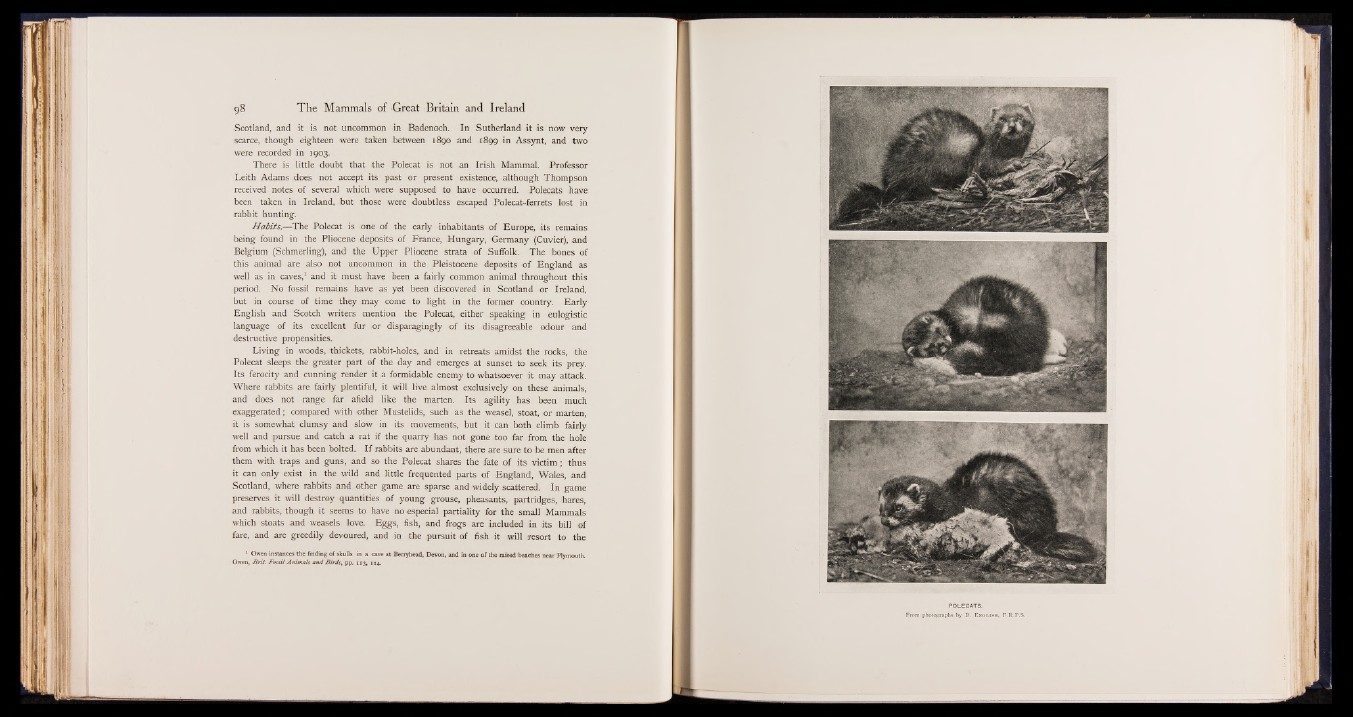
Scotland, and it is not uncommon in Badenoch. In Sutherland it is now very
scarce, though eighteen were taken between 1890 and 1899 in Assynt, and two
were recorded in 1903.
There is little doubt that the Polecat is not an Irish Mammal. Professor
Leith Adams does not accept its past or present existence, although Thompson
received notes of several which were supposed to have occurred. Polecats have
been taken in Ireland, but those were doubtless escaped Polecat-ferrets lost in
rabbit hunting.
H a b its—^The Polecat is one of the early inhabitants of Europe, its remains
being found in the Pliocene deposits of France, Hungary, Germany (Cuvier), and
Belgium (Schmerling), and the Upper Pliocene strata of Suffolk. The bones of
this animal are also not uncommon in the Pleistocene deposits of England as
well as in caves,1 and it must have been a fairly common animal throughout this
period. No fossil remains have as yet been discovered in Scotland or Ireland,
but in course of time they may come to light in the former country. Early
English and Scotch writers mention the Polecat, either speaking in eulogistic
language of its excellent fur or disparagingly of its disagreeable odour and
destructive propensities.
Living in woods, thickets, rabbit-holes, and in retreats amidst the rocks, the
Polecat sleeps the greater part of the day and emerges at sunset to seek its prey.
Its ferocity and cunning render it a formidable enemy to whatsoever it may attack.
Where rabbits are fairly plentiful, it will live, almost exclusively on these animals,
and does not range far afield like the marten. Its agility has been much
exaggerated; compared with other Mustelids, such as the weasel, stoat, or marten,
it is somewhat clumsy and slow in its movements, but it can both climb fairly
well and pursue and catch a rat if the quarry has not gone too far from the hole
from which it has been bolted. I f rabbits are abundant, there are sure to be men after
them with traps and guns, and so the Polecat shares the fate of its victim ; thus
it can only exist in the wild and little frequented parts of England, Wales, and
Scotland, where rabbits and other game are sparse and widely scattered. In game
preserves it will destroy quantities of young grouse, pheasants, partridges, hares,
and rabbits, though it seems to have no especial partiality for the small Mammals
which stoats and weasels love. Eggs, fish, and frogs are included in its bill of
fare, and are greedily devoured, and in the pursuit of fish it will resort to the
1 Owen instances the finding of skulls in a cave at Berryhead, Devon, and in one of the raised beaches near Plymouth.
Owen, B rit. Fossil Animals and Birds, pp. « 3 , 114.